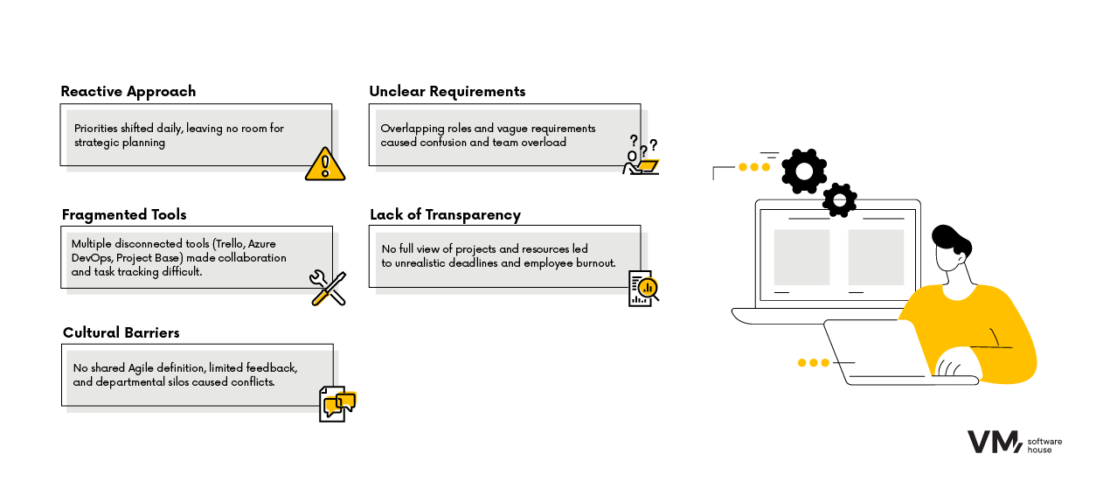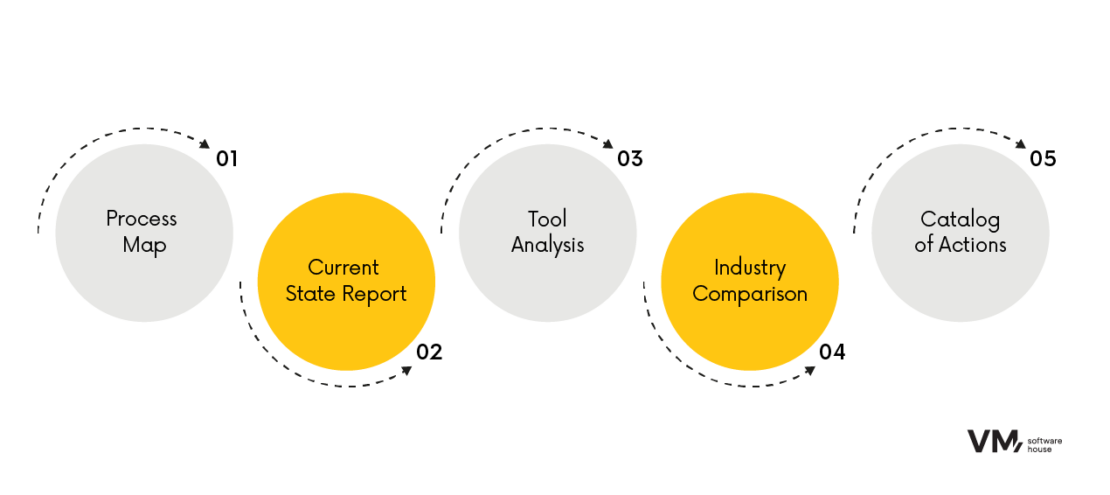
Table of Contents
Why It’s Always Worth Starting with Analysis
Agile — the popular buzzword in tech companies — promises flexibility, improved communication, and faster delivery of customer value. In theory. In practice, however, Agile often exists only on paper. Sure, some steps are taken, a few practices are selectively applied, but the results frequently fall short. That’s why before making any changes, it’s worth taking a step back and asking, “How do we really work today?” We can only move forward with purpose when we clearly understand our starting point. Without thorough analysis, it’s easy to fall into the trap of superficial improvements that fail to address the core issues.
Strong Foundations vs. Hidden Challenges
We partnered with one of the largest online printing companies in Europe. Its business relies on automated production processes and a complex e-commerce platform. IT is the driving force behind the entire operation, responsible for integrating new machinery, handling orders, and supporting sales. While teams were theoretically operating using Scrum, the reality told a different story.
The company faced several key challenges:
- Reactive mindset – Priorities shifted daily. Team leaders and members spent most of their time “putting out fires,” making it nearly impossible to focus on long-term goals.
- Lack of transparency – No one had a complete view of ongoing projects, available resources, or dependencies. This often led to unrealistic deadlines, resulting in burnout and overload.
- Unclear requirements – Blurred lines between project managers and product owners meant tasks kept piling up on team members, leading to frustration.
- Fragmented tools – Trello, Azure DevOps, Project Base – each tool was used in isolation without a unified ecosystem, which hindered collaboration.
- Cultural barriers – There was no shared definition of Agile within the company, no open feedback culture, and interdepartmental conflicts were common.

It’s a textbook example of a company that was “doing Agile,” but not getting the results they expected.
What Did the Analysis Phase Look Like From the Inside?
To identify the root causes of the problems, we began with a full inventory and process analysis.
In practice, this meant:
- In-depth interviews – 8 conversations with stakeholders at various levels, from top management to developers.
- Meeting observations – We participated in different Agile routines: stand-ups, sprint planning sessions, reviews, and task prioritization meetings.
- Data analysis – Notes and transcripts served as the basis for identifying recurring issues and tracing them back to their sources.
Instead of Rolling Out Changes Across the Entire Organization, We Started with a Pilot
We selected one team to serve as a “testing ground” for the recommendations developed during the analysis phase. This allowed us to continuously validate what was working and what needed adjustment—before scaling the solutions to the rest of the company. This approach helped us avoid confusion and disruption, while ensuring that other departments could continue their work without interruption.
Our Step-by-Step Approach
- Process map – A visual and textual representation of actual workflows, highlighting bottlenecks and role conflicts.
- Current state report – A SWOT analysis that revealed strengths (e.g., an engaged team) and clearly identified areas for improvement.
- Tool analysis – An evaluation of which systems should be integrated and which ones could be phased out.
- Industry comparison – A benchmarking of the company’s practices against recognized frameworks (e.g., Scrum) to assess Agile maturity.
- Action catalog – Over 25 concrete recommendations categorized into strategy, processes, roles, culture, and tools.

Importantly, each recommendation included specific, actionable guidance the company could implement with ease.
Early Results and Real Change
Just a few weeks after implementing the initial actions, the company observed:
- Greater transparency – With improved tools and a clear process map, everyone knew what others were working on.
- A shared language – The analysis created space for open dialogue across departments on equal footing.
- A solid foundation for decision-making – The action list helped leadership prioritize changes and plan the next steps of the transformation.
What Does This Mean for Other Companies?
The good news is, you don’t have to be a large online printing business to learn from this story. Many organizations claim to work in Agile, but only an objective analysis can show whether it’s truly Agile in practice—or just on paper. Without this step, it’s easy to waste time on improvements that miss the core of the problem.
What’s Next? Let’s Talk About Your Transformation
The company is now ready for the next phase: scaling up the most impactful improvements. The foundation is strong: transparent processes, better tools, and a shared understanding of purpose. Now it’s time for consistent execution. If you’re wondering whether your Agile is truly effective—or if it only exists in polished presentations—start with an analysis. It’s an investment that will help you avoid costly mistakes and speed up meaningful change.













